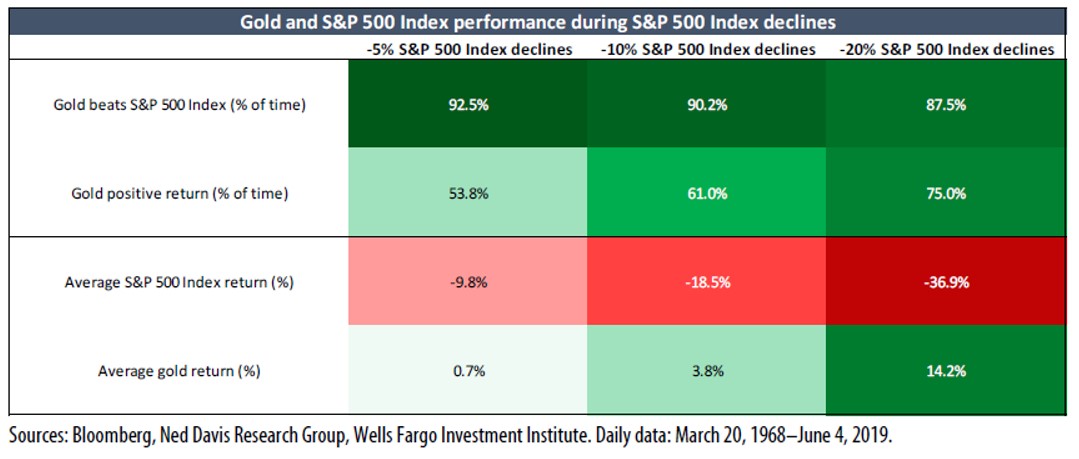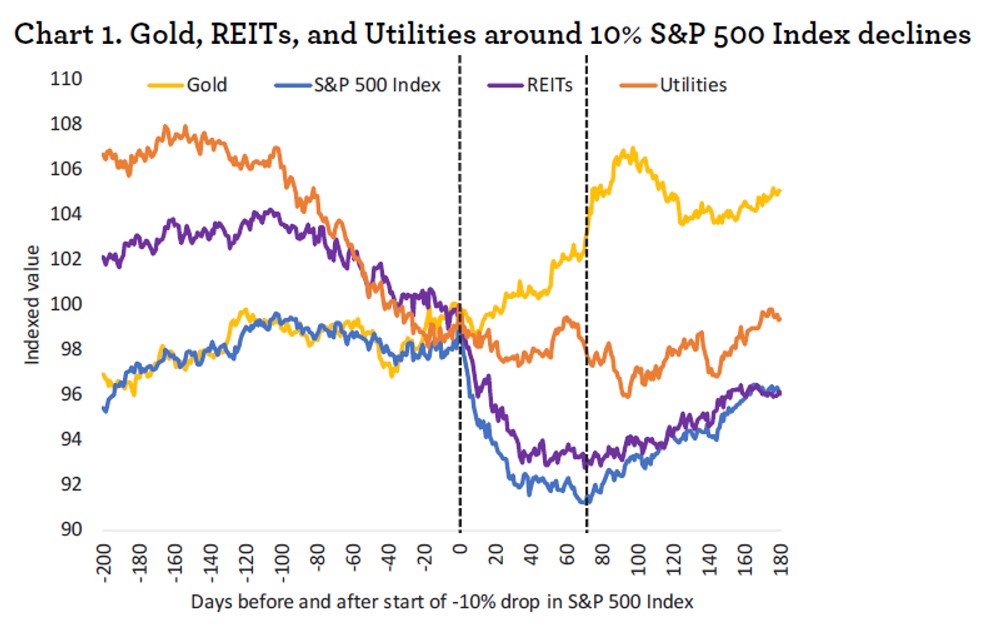Alt Investments
Gold Can Protect Downside Threats, But Don't Get Carried Away - Institute

The organization probes into the claim that gold is a safe-haven asset and at the same time argues that there are reasons to be optimistic about a resolution over trade tariffs.
Gold can insure against stock market tumbles but its protection
qualities don’t shine as bright as some people assume, the
Wells
Fargo Investment Institute says. Its comments come as
equities have been volatile recently.
The WFII, which provides research ideas and analysis, said that
gold’s centuries-old track record as a store of value and medium
of exchange merits respect, and explains why investors - even in
the 21st century - treat it as a safe haven. While the Institute
doesn’t scorn such ideas, it urges investors to be
careful.
“To be clear, we believe that gold holds a place in most
investors’ portfolios - most of the time. But like other
investments, timing and position sizing are keys. At $1,340
today, we do not think that gold is any great bargain. We’re
waiting for much lower prices,” John LaForge, head of real asset
strategy at the Institute, said in a note. His comments are
accompanied by updates about the Institute’s asset allocations,
showing it expects some resolution to global trade deals and is
not yet ready to get defensive over equities.
Gold’s status as a safe-haven asset is well known, and there are
commentators who, even if they eschew the mocking label “gold
bug”, argue that the yellow metal should be given more respect
than it has received since the advent of state central banking
and fiat currencies in the 19th and 20th centuries. Ironically,
even though British economist John Maynard Keynes called the old
Gold Standard system a “barbarous relic”, central banks today
continue to hold significant amounts of gold, as in the case of
China. In Switzerland, the country even held a public referendum
about four years ago on the proposition that the Swiss National
Bank should hold at least 20 per cent of its reserves in gold
(that proposal was heavily defeated). Additionally, the recent
rise (at times) of crypto-currencies such as Bitcoin plays to the
idea that they are digital equivalents of gold, given that
cryptos are designed to be finite in quantity, like
gold.
Rich history
The WFII argues that gold’s history can sway investors’ minds,
not always correctly.
“Gold has a rich history as both a store of value (investments,
jewelry, bars, etc) and money (coins, etc). Found nearly 5,000
years ago, gold was first coined roughly 3,700 years ago (in the
area now known as Turkey). Stocks and bonds, on the other hand,
were created in the last 400 years. Impervious to both air and
water, gold has the unique benefit of literally surviving time,
meaning essentially all of the gold ever mined still exists
somewhere (even if sunk off the coast of Florida). The same
cannot be said of other financial assets. For example, no
country’s paper currency has survived time. Not one,” LaForge
says in his note.
The flipside of the coin, so to speak, is that gold’s endurance
as a form of money lures people into thinking it is a great safe
haven, but it has not always provided the protection people
assume, he continues.
Gold can be useful when stock markets are falling, he says. For example, it has typically outperformed the S&P 500 Index of US stocks when that benchmark has fallen.

Source: Wells Fargo Investment Institute
It has also tended to outperform the most defensive stock sectors, when the S&P 500 was correcting.

Source: Wells Fargo Investment Institute
But, LaForge says gold does not offer “golden protection”, however, because while it has historically fared better than the stock market during a downturn, it has not always made positive returns for investors. Figures show that gold prices are positive for only 60-70 per cent of the time and that is when stocks have corrected. Also, gold hasn’t even been the best defensive asset to seek refuge in.
Another cautionary note is that gold may provide some downside
risk insurance, LaForge says. He does not advocate that investors
should boost holdings now. “For clients willing to endure some
short-term choppiness in 2019, equity markets appear to have more
upside than gold,” he says.
Too early to be defensive
The Institute goes on to argue that while US-China trade rows and
other geopolitical uncertainties make markets choppy, it is too
early for investors to turn defensive and argues that the US
business cycle has room to run. The Institute is neutral on US
large-cap stocks and mid-caps, underweight US small-caps and
neutral developed market ex-US equities. It is strongly
overweight emerging market stocks.
“We continue to believe that the trade conflicts will be
resolved, even if not as swiftly or completely as originally
anticipated. Markets likely will respond favorably to a lessening
of these trade-related headwinds. Economic growth in the US is
forecast to be slower than last year, but still above 2 per cent.
As such, we believe this environment will continue to favor
cyclical sectors as the most likely beneficiaries going forward,”
LaForge says.
Other asset classes
The Institute has the following weightings on other areas such as
bonds and commodities:
Neutral US taxable investment-grade fixed income; overweight US
short-term taxable fixed income; neutral US intermediate-term
taxable fixed income; neutral US long-term taxable fixed income
and underweight high-yield taxable fixed income. It is also
underweight developed markets ex-US fixed income. The
organization is also neutral on commodities and underweight
private real estate and public real estate.
Within the alternative asset class space, the Institute is
neutral on private equity and macro hedge funds and event-driven
hedge funds, but overweight equity hedge-style hedge funds and
relative value funds. It is overweight private debt.